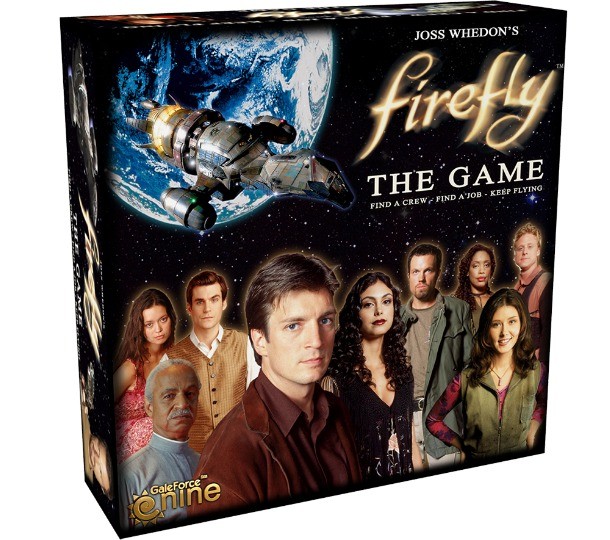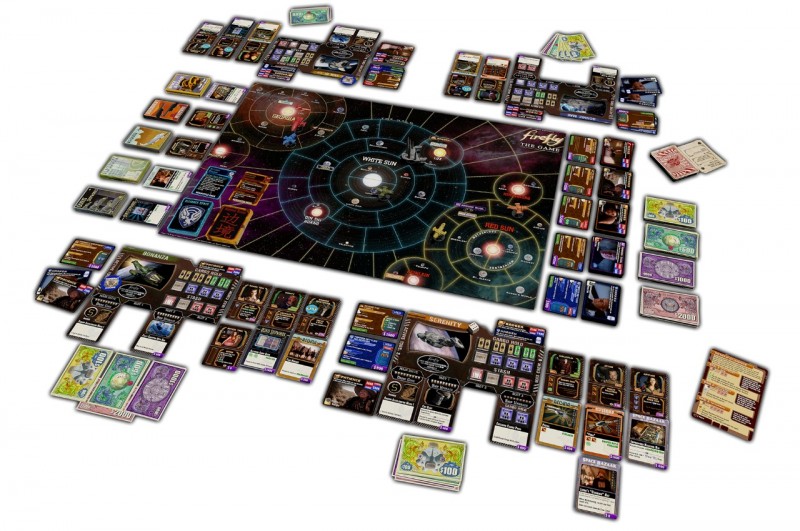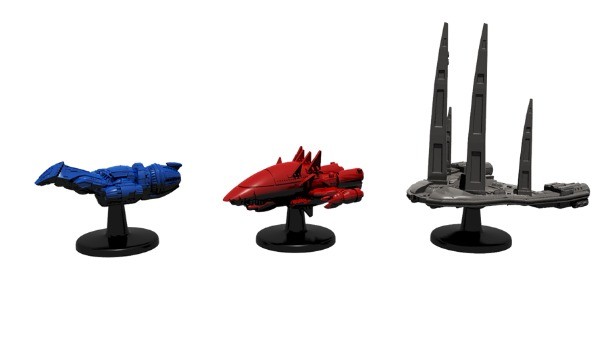Top Of The Table – Firefly: The Game

Few fan bases are more vocal and enthusiastic than the Firefly crowd. Forever wronged by the untimely end of the beloved show, enthusiasts for Joss Whedon’s sci-fi universe carry a torch that continues to burn. For those always hungry for a return trip to the Verse, Gale Force Nine’s Firefly: The Game is an easy recommendation. Filled with nods to the fiction, beautiful components that call to mind the best elements of the show, and mechanics that feel like you’re playing out new Firefly episodes, the board game version of Firefly is a fitting homage to and extension of the cult favorite franchise.
In this month’s tabletop spotlight, we take a closer look at Firefly: The Game, and help you decide if a journey through space with Captain Reynolds and crew is the right fit for your gaming group.
Getting Started
Firefly is a competitive game for 1-4 players that has each gamer captaining a Firefly-class ship on its journey across the Verse. Like Mal and his misfit crew, each player must find jobs to complete and keep flying in the face of constant threats, whether those come from a lack of fuel, an Alliance cruiser, or the deadly Reavers.
Gameplay unfolds on a large board that depicts the stars and planets of the Firefly universe, with lots of empty space between them to be crossed in the pursuit of jobs both legal and illicit. Unpainted but colored plastic ship minis add some vibrancy to the otherwise dark-colored board, but it’s the components that sit beside the board that really impress. Beautifully designed cards show off images from the TV show, and each character has a player mat representing his ship and cargo. Perhaps the most impressive visual pieces in the game are the 150 currency bills – they’re the best-looking money I’ve ever seen in a board game.
Setup involves a good bit of deck shuffling and dispensation of starting money and supplies, which I found could drag with new players at the table – I recommend presetting the table for a set group of players to get things going quickly.
In a cool twist, each game session carries its own story – like a single episode of the TV show. The six included scenarios offer fun variations on the experience, including a solo option for new game owners to familiarize themselves with the rules. With a full group of three to four players, plan for a full evening of gaming. My playthroughs averaged around three hours apiece, though the box implies an hour shorter -- which might be a possibility with an experienced group.
[Next up: Telling your own story in the Verse]

Theme and Story
Appropriately, Firefly’s greatest strength and struggle echoes the show upon which it is based. The rich storytelling, unusual jargon, and richly realized science-fiction trappings shine through in every turn and with every action played. But like the show that sometimes struggled to find an audience early on, the game is squarely targeted to fans willing to engage with the unusual Old West meets sci-fi concept. While the game’s strategy and mechanics hold up well regardless of your knowledge of the Firefly universe, the same can’t be said of the many cards, quotes, and events that unfold in any given session – all of which fully embrace and expect a love of the franchise. But let’s be honest; if you didn’t already love the story of Serenity’s trek through outer space, this game probably isn’t ending up on your table in the first place.
The themes of living on the edge of breakdown and survival persist throughout the game, as do the hard choices facing a captain in the Verse – balancing violence and diplomacy, dodging the law, and dealing with a varied crew that might have their own ideas about how things should be. Moreover, Firefly does a great job of presenting a distinct storytelling experience with clear stages and events. Your growing crew, ship upgrades, and often botched missions tell a story that’s personal to you. The only place Firefly stumbles is in linking your unfolding story with the other players at the table; the game includes little player interaction during your lonely flights through space. For my part, that rarely affected my enjoyment – while the game mechanics seldom brought me into interaction with the other players, the stories we were each laughing about as they developed kept the table active and engaged.
Gameplay
Acting out your turn in Firefly is all about pushing your luck. A standard turn often involves flying some distance across space, which can be done carefully, at little risk, or at a higher fuel expense – a full burn that invites potential conflict, as represented by potential card events for each extra space you move. Daring captains can cross large distances in one turn, but risk big problems along the way.
Contacts around the board provide jobs, usually sending you to a distant planet and what is likely to be a challenging confrontation. A simple-to-grasp skill test mechanic involves dice rolling and adding relevant modifiers from equipment and crew, but I especially like the way these skill tests can sometimes result in different degrees of success or failure, depending on your final total. Some jobs demand you “misbehave” in order to progress, veering your captain and crew into illegal activity in the name of getting paid. Different playable captain characters are likely to approach each job differently, depending on their preference between moral and immoral actions.
In between jobs is the fun of upgrading your ship and developing your crew, which is my favorite part of the game. New crew can come aboard, but not only do they take a cut of the pay, they may bring with them their own problems, like a warrant from the Alliance. You can choose not to pay your crew after a job, but they’ll get disgruntled, and might get lured away to another crew. Meanwhile, you’re always rigging your ship with new upgrades to increase movement range, expand storage space, and more.
Whether pushing your ship great distances, or taking chances with your crew dealings, most of Firefly’s mechanics involve taking big risks in the name of greater rewards.
[Next up: How complicated is it to learn, and where can I track down a copy?]

Complexity
As mentioned above, initial setup for Firefly can be a little overwhelming for new players, but completing turns and moving the game forward is a cinch. Every player has a simple choice on each turn to complete two actions: fly (move), buy (gear and services), deal (taking jobs), and work (completing jobs). If someone at the table is familiar with each of those fundamental actions, it’s not hard to get a new group of players up to speed in no time.
With that in mind, I strongly recommend someone in the group (likely the game’s owner) takes the time to play the solo game variant at least once before playing with others. That simple scenario does a great job of establishing the game systems.

What else do I need to know?
Suggested retail price for Firefly: The Game is $50, but you can expect to find it up to $20 cheaper at some retailers. Your local hobby store should be able to track down a copy, as well as help get you started with learning the game. Alternately, online retailers like Cool Stuff Inc. or Amazon are good options.
Firefly already has a few small expansions on the market, including the Breakin’ Atmo set of new job and supply cards, as well as the soon-to-release and more extensive Pirates & Bounty Hunters set – which aims to add more of the player interaction elements that the core game lacks.
Independent of any expansions, Firefly: The Game offers a great chance to return to Joss Whedon’s outer space epic for new adventures through the Verse. Push-your-luck mechanics provide the sense of risk and flying by the seat of your pants that the franchise requires. A wide selection of cards and story scenarios keep the game fresh after repeated plays, and beautifully designed internal components bring the setting to life. The consistent use of series terminology, characters, and jargon doesn’t make it a great choice for non-fans, but players already enmeshed in the Firefly fiction will rejoice at the melding of strategy and storytelling.
Looking to expand your tabletop library? Check out my picks for the best tabletop games of 2013 and 2012. In addition, you can read more extensive write-ups like this one on games including Ascension, Tannhauser, Castle Ravenloft, Yomi, Star Trek: Fleet Captains, Agents of SMERSH, A Touch of Evil, Mage Wars, The Adventurers: Pyramid of Horus, Dixit, Star Wars: Edge of the Empire. Lords of Waterdeep, Pathfinder Adventure Card Game, Eldritch Horror, Robinson Crusoe, or Takenoko.

Get the Game Informer Print Edition!
Explore your favorite games in premium print format, delivered to your door.
- 10 issues per year
- Only $4.80 per issue
- Full digital magazine archive access
- Since 1991









